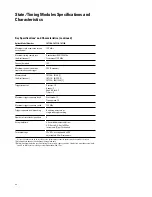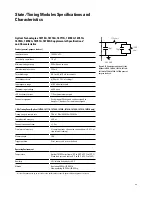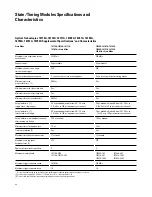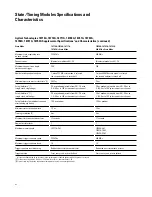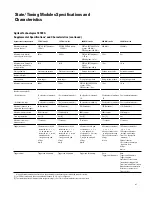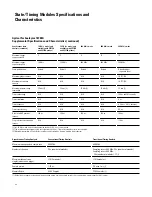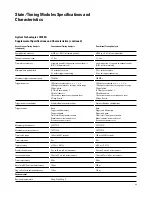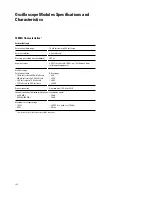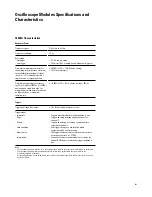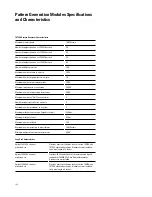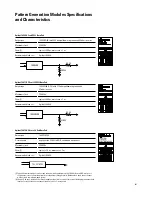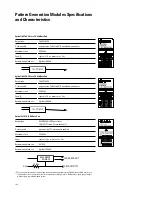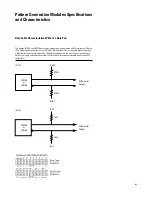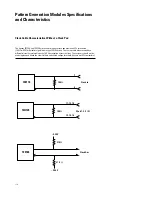
97
State/Timing Modules Specifications and
Characteristics
Agilent Technologies 16760A
Supplemental Specifications* and Characteristics (continued)
Synchronous state analysis
1.5 Gb/s mode
1.25 Gb/s mode
800 Mb/s mode
400 Mb/s mode
200 Mb/s mode
Maximum data rate
E5378A, E5379A probes:
E5378A, E5379A probes:
E5378A, E5379A, E5382A
400 Mb/s
200 Mb/s
on each channel
1.5 Gb/s
1.25 Gb/s
probes: 800 Mb/s
E5380A probe: 600 Mb/s
Minimum clock interval,
667 ps
800 ps
E5378A, E5379A probes:
2.5 ns
5 ns
active edge to active edge*
1.25 ns
E5380A probe: 1.67 ns
Minimum state clock pulse
N/A
N/A
E5378A, E5379A probes:
1.5 ns
1.5 ns
width with clock polarity
600 ps
rising or falling
E5380A probe: 800 ps
Clock periodicity
Clock must be periodic
Clock must be periodic
Periodic or aperiodic
Periodic or aperiodic
Periodic or aperiodic
Number of clocks
1
1
1
1
1
Clock polarity
Both edges
Both edges
Rising, falling, or both
Rising, falling, or both
Rising, falling, or both
Minimum data pulse width
600 ps
750 ps
E5378A, E5379A, E5382A
1.5 ns
1.5 ns
probes: 750 ps
E5380A probe: 1.5 ns
Number of channels [1]
• With time tags
16 x (number of modules) -
16 x (number of modules) -
34 x (number of modules) -
34 x (number of modules) - 34 x (number of modules)
8
8
16
16
• Without time tags
16 x (number of modules)
16 x (number of modules)
34 x (number of modules)
34 x (number of modules) 34 x (number of modules)
Maximum channels on a
80 (5 modules)
80 (5 modules)
170 (5 modules)
153 (5 modules)
170 (5 modules)
single time base and trigger
Maximum memory depth
128M samples
128M samples
64M samples
32M samples
32M samples
Time tag resolution
4 ns [2]
4 ns [2]
4 ns [2]
4 ns [2]
4 ns
Maximum time count
17 seconds
17 seconds
17 seconds
17 seconds
17 seconds
between states
Trigger resources
3 Patterns on each pod
3 Patterns on each pod
4 Patterns on each pod
8 Patterns evaluated as 16 Patterns evaluated as
evaluated as =,
≠
, >, <,
evaluated as =,
≠
, >, <,
evaluated as =,
≠
, >, <,
=,
≠
, >, <,
≥
,
≤
=,
≠
, >, <,
≥
,
≤
≥
,
≤
on one pod; or
≥
,
≤
on one pod; or
≥
,
≤
on one pod; or
4 Ranges evaluated as
15 Ranges evaluated as
evaluated as =,
≠
across
evaluated as =,
≠
across
evaluated as =,
≠
across
in range, not in range
in range, not in range
multiple pods; or
multiple pods; or
multiple pods; or
2 Occurrence counters
Timers: 2 x (number of
1 range on each pod
1 range on each pod
2 ranges on each pod
4 Flags
modules) – 1
4 Flags
4 Flags
4 Flags
Arm in
2 Global counters
Arm in
Arm in
Arm in
1 Occurrence counter per
sequence level
4 Flags
Arm in
Trigger actions
Trigger and fill memory
Trigger and fill memory
Trigger and fill memory
Goto
Goto
Trigger and fill memory
Trigger and fill memory
Trigger and goto
Store/don’t store sample
Turn default storing on/off
Timer start/stop/pause/resume
Global counter increment/reset
Occurrence counter reset
Flag set/clear
* All specifications noted by an asterisk are the performance standards against which the product is tested.
[1] In 1.25 Gb/s mode, only the even-numbered channels (0, 2, 4, etc.) are acquired.
[2] The resolution of the hardware used to assign time tags is 4 ns. Times of intermediate states are calculated.




